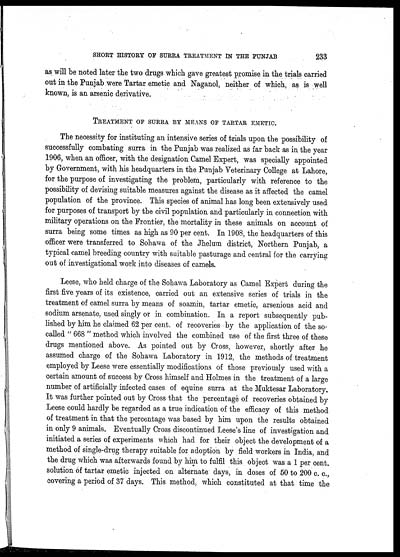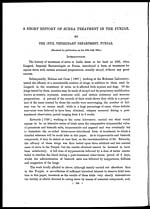Medicine - Veterinary > Veterinary colleges and laboratories > Indian journal of veterinary science and animal husbandry > Volume 4, 1934 > Original articles > Short history of surra treatment in the Punjab
(261) Page 233
Download files
Individual page:
Thumbnail gallery: Grid view | List view

SHORT HISTORY OF SURRA TREATMENT IN THE PUNJAB 233
as will be noted later the two drugs which gave greatest promise in the trials carried
out in the Punjab were Tartar emetic and Naganol, neither of which, as is well
known, is an arsenic derivative.
TREATMENT OF SURRA BY MEANS OF TARTAR EMETIC.
The necessity for instituting an intensive series of trials upon the possibility of
successfully combating surra in the Punjab was realized as far back as in the year
1906, when an officer, with the designation Camel Expert, was specially appointed
by Government, with his headquarters in the Punjab Veterinary College at Lahore,
for the purpose of investigating the problem, particularly with reference to the
possibility of devising suitable measures against the disease as it affected the camel
population of the province. This species of animal has long been extensively used
for purposes of transport by the civil population and particularly in connection with
military operations on the Frontier, the mortality in these animals on account of
surra being some times as high as 90 per cent. In 1908, the headquarters of this
officer were transferred to Sohawa of the Jhelum district, Northern Punjab, a
typical camel breeding country with suitable pasturage and central for the carrying
out of investigational work into diseases of camels.
Leese, who held charge of the Sohawa Laboratory as Camel Expert during the
first five years of its existence, carried out an extensive series of trials in the
treatment of camel surra by means of soamin, tartar emetic, arsenious acid and
sodium arsenate, used singly or in combination. In a report subsequently pub-
lished by him he claimed 62 per cent. of recoveries by the application of the so-
called " 668 " method which involved the combined use of the first three of these
drugs mentioned above. As pointed out by Cross, however, shortly after he
assumed charge of the Sohawa Laboratory in 1912, the methods of treatment
employed by Leese were essentially modifications of those previously used with a
certain amount of success by Cross himself and Holmes in the treatment of a large
number of artificially infected cases of equine surra at the Muktesar Laboratory.
It was further pointed out by Cross that the percentage of recoveries obtained by
Leese could hardly be regarded as a true indication of the efficacy of this method
of treatment in that the percentage was based by him upon the results obtained
in only 9 animals. Eventually Cross discontinued Leese's line of investigation and
initiated a series of experiments which had for their object the development of a
method of single-drug therapy suitable for adoption by field workers in India, and
the drug which was afterwards found by him to fulfil this object was a 1 per cent.
solution of tartar emetic injected on alternate days, in doses of 50 to 200 c. c.,
covering a period of 37 days. This method, which constituted at that time the
Set display mode to: Large image | Zoom image | Transcription
Images and transcriptions on this page, including medium image downloads, may be used under the Creative Commons Attribution 4.0 International Licence unless otherwise stated. ![]()
| Permanent URL | https://digital.nls.uk/75234499 |
|---|
| Description | Covers articles from 1934. |
|---|




